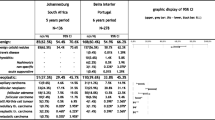Abstract
The literature on the relationship between diet and thyroid cancer (TC) risk and the higher incidence of TC among Asian immigrants to the US compared to second and third generation subgroups has prompted epidemiologists to hypothesize that increased levels of iodine consumption may be associated with TC risk, particularly among persons with a history of clinical or subclinical thyroid dysfunction. At the University of Missouri Research Reactor (MURR), we have applied epiboron neutron activation analysis to investigate human nails as a dietary monitor for iodine. Preliminary studies have indicated a positive correlation between dietary iodine intake and the concentration of iodine in toenails. However, these studies are confounded by high iodine levels (up to 30 ppm) in approximately 5% of the nails studied. We hypothesize that, in the subjects we have studied, the high iodine levels may be due to iodine-containing medications, in particular contrast-agents containing iopamidol. This paper will report on longitudinal studies using contrast agent subjects who were followed-up for almost two years compared to a longitudinal control and a population mean. Based on this study, we suggest that iodine-containing contrast agents contaminate nail samples via non-specific binding in the short term followed by incorporation in the nail as a result of absorption.
Similar content being viewed by others
References
E. J. Wayne, D. A. Koutrass, W. D. Alexander, Clinical Aspects of Iodine Metabolism, Oxford, Blackwell, 1964.
S. Hunt, J. Groff, West Publishing Co., 1990.
C. P. Barsano, Environ. Health Prespec., 38 (1981) 71.
national Research Council, Recommended dietary allowances. Washington, D.C., National Academy Press, 1989.
M. Allegrini, J. A. T. Pennington, J. Tanner, J. Am. Diet. Assoc., 83 (1983) 24.
W. Mertz, Trace elements in Human and Animal Nutrition, Vol. 2, 5th ed., p. 173.
National Research Council, Diet and Health, National Academy Press, Washington, DC, 1989.
S. Franceschi, R. Talamini, A. Fassina, E. Bidoli, Tumori, Aug., (1990) 331.
D. Blumenthal, FDA Consumer Magazine, DDHH Publi No. (FDA) 91-2235.
FDA ref Sec. 651.100 Ethylenediamine dihydroiodide (EDDI) (CPG 7125.18).
M. D. Glascock, W. Z. Tian, W. D. Ehmann, J. Radioanal. Nucl. Chem., 92 (1985) 379.
V. L. Spate, J. S. Morris, S. Chickos, C. K. Baskett, M. M. Mason, T. P. Cheng, C. L. Reams, C. West, C. Furnee, W. Willett, P. Horn-Ross, J. Radioanal. Nucl. Chem., 195 (1995) 21.
BRACCO DIAGNOSTICS spec sheet j3-652y revised June 1995.
Author information
Authors and Affiliations
Rights and permissions
About this article
Cite this article
Spate, V.L., Morris, J.S., Nichols, T.A. et al. Longitudinal study of iodine in toenails following IV administration of an iodine-containing contrast agent. J Radioanal Nucl Chem 236, 71–77 (1998). https://doi.org/10.1007/BF02386320
Received:
Issue Date:
DOI: https://doi.org/10.1007/BF02386320



